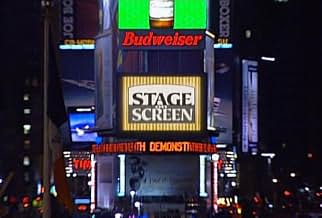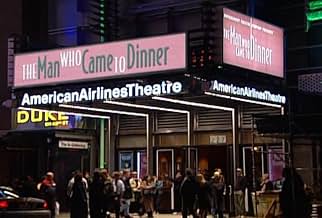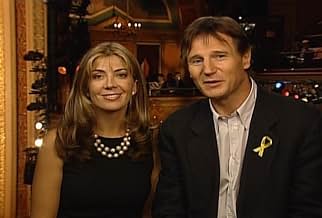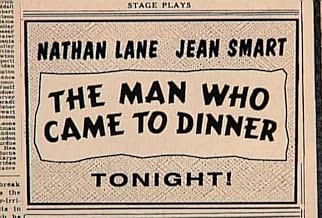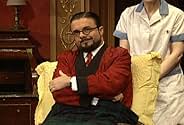Adicionar um enredo no seu idiomaCantankerous theatre critic Sheridan Whiteside falls on an icy sidewalk, breaks his hip, and is temporarily stranded at the Ohio home of Richard Stanley and his family. While he's there, Whi... Ler tudoCantankerous theatre critic Sheridan Whiteside falls on an icy sidewalk, breaks his hip, and is temporarily stranded at the Ohio home of Richard Stanley and his family. While he's there, Whiteside turns life upside-down for everyone.Cantankerous theatre critic Sheridan Whiteside falls on an icy sidewalk, breaks his hip, and is temporarily stranded at the Ohio home of Richard Stanley and his family. While he's there, Whiteside turns life upside-down for everyone.
- Direção
- Roteiristas
- Artistas
Harriet Sansom Harris
- Maggie Cutler
- (as Harriet Harris)
Jeff Hayenga
- John
- (as Jeffrey Hayenga)
- Direção
- Roteiristas
- Elenco e equipe completos
- Produção, bilheteria e muito mais no IMDbPro
Avaliações em destaque
I gave this DVD version of the play a 10 simply for the scene stealing performance by Byron Jennings. He is truly amazing as Beverley Carlton. This is not to be missed by anyone who appreciates uncommonly gifted acting.
Nathan Lane as Sheridan Whiteside is the perfect foil for him. His line about the Lindbergh baby is hilarious, and Byron Jennings' reaction is well in tune with Nathan Lane's humor. It's rare to watch actors who are so much in sync with each other. Too often a film or play will feature great talent playing opposite mediocre talent. Speaking of which, the actress who plays Sheridan Whiteside's secretary is not of their caliber and detracts from their performance.
The play's greatest weakness is that Mr. Jennings appears in just one scene.
Still, it's amazing enough to be worth the cost of purchase.
It's so unfortunate that American film and theater productions place greater value on perfectly photogenic looks, rather than exceptional talent. If only film and theater goers were able to recognize and value substance and depth of character, they would be able to look beyond the shallowness and one dimensional "acting" that is foisted on us.
Nathan Lane as Sheridan Whiteside is the perfect foil for him. His line about the Lindbergh baby is hilarious, and Byron Jennings' reaction is well in tune with Nathan Lane's humor. It's rare to watch actors who are so much in sync with each other. Too often a film or play will feature great talent playing opposite mediocre talent. Speaking of which, the actress who plays Sheridan Whiteside's secretary is not of their caliber and detracts from their performance.
The play's greatest weakness is that Mr. Jennings appears in just one scene.
Still, it's amazing enough to be worth the cost of purchase.
It's so unfortunate that American film and theater productions place greater value on perfectly photogenic looks, rather than exceptional talent. If only film and theater goers were able to recognize and value substance and depth of character, they would be able to look beyond the shallowness and one dimensional "acting" that is foisted on us.
What a treat to watch. Having recently portrayed the role of Mr. Whiteside in a local civic theatre production, I was reluctant to view the movie beforehand, so that I might give the pompous "Babys Breath" my own take. I am proud to report that as much as a a non professional can, I approached the character much like Mr. Lane did.(Only with a bit more heavy handed shouting)Jean Smart is always a treat to watch in anything she does, and I agree, that the role of Banjo was handled with the appropriate lunacy. Also excellent was Harriet Harris. She was able to convey the intimacy that comes from years of being someones right hand, and then to lose that when you have been sidelined by that very same person. It is a wonderful movie to watch. And one of my most favorite roles on stage.
PBS is to be commended for its "Stage on Screen" series premiere with this live broadcast from the newly restored 42nd Street theater district in New York City. While Nathan Lane has less of the imperious acidic bite that Monty Woolley brought to the 1942 film, Lane and the play still have punch and sparkle.
Of necessity, the live stage performance lacks the brisk pace of the movie simply because of the stops for scene changes or intermissions between acts. In addition, the classic film was pared down for length. In this broadcast, the interruptions were at least filled with chatty information about the play, the people represented in the play, and the resurrection of 42nd Street.
Despite or because of its dated allusions and overt references, the play is a delightful slice of real life in America just prior to World War II. The work stands up well and is likely to be a classic of 20th Century American theater.
Of necessity, the live stage performance lacks the brisk pace of the movie simply because of the stops for scene changes or intermissions between acts. In addition, the classic film was pared down for length. In this broadcast, the interruptions were at least filled with chatty information about the play, the people represented in the play, and the resurrection of 42nd Street.
Despite or because of its dated allusions and overt references, the play is a delightful slice of real life in America just prior to World War II. The work stands up well and is likely to be a classic of 20th Century American theater.
The 1942 film THE MAN WHO CAME TO DINNER was possibly the best comedy film that Bette Davis ever appeared in, but while she got starring position in the film's credits, the real star (who went to town as a result) was the great Monty Woolley, recreating his magnificent acid tongued curmudgeon Sheridan Whiteside. It was one of the rare occasions when a stage performance of importance was saved on film.
Fifty eight years later (forgetting one disastrous television version with Orson Welles as Whiteside in 1972) PBS showed this production of the stage revival of the play with Nathan Lane in the Whiteside role. Lane played the role perfectly, basing it (physically) closer to the original figure Whiteside is based on - writer, critic, actor, radio personality, and Algonquin Round Table Wit Alexander Woolcott. His facial appearance included wearing the round eye frame glasses that Woolcott wore all the time. Lane did not have the crusty, elderly asperity of the great Woolley, but he did have a malevolent elfin charm reminiscent of Woolcott (a man who was all too easy to dislike - Woolcott was also the model for Waldo Lydecker in LAURA, which just goes to show his popularity).
One of the problems with comedy (or drama generally speaking) is the fact that the works can be dated in their references. When, in one of his plays, Shakespeare refers to "the Great Sophy" it is to some long ago forgotten English traveler and diplomat named Shirley who went to Persia. Most of us see the foot note of this 16th Century reference and try to concentrate on the rest of the play that still is strong and relevant to us. But with THE MAN WHO CAME TO DINNER the great problem is the barrage of trivia that comes out of the play. Woolcott's two Algonquin friends (Kaufman and Moss Hart) added small bits of biography to his stage version, which everyone who knew Woolcott would recognize. The theater critic knew everyone of importance in the theater. So he has a scene with a clone of Noel Coward named Beverley Carlton (to add to perfecting the imitation of Coward, Kaufman and Hart asked Cole Porter, a close friend of Monty Woolley, to write a song for "Carlton" to sing to Whiteside, that was in Coward's distinct delicate style). The close friend of Whiteside who shows up as a comic "deus ex ma china" in the play is "Banjo." This was based on Woolcott's close Algonquin friend Harpo Marx.
But most of the references are quite arcane. Who is Elizabeth Sedley? Well, it is a reference to a celebrated murder case defendant, whose career would have intrigued Woolcott, the great amateur criminologist. What are the references to Beebe and Byrd? This version got around the problems using mock 1930s newspaper headlines chronicling William Beebe the oceanographer and Admiral Richard Byrd, the Polar explorer. This sounds cumbersome, but it was far more effective and useful to the viewers than the idiocy of the 1972 Welles' version where the script was "up-dated" meaninglessly.
The program was an excellent version of the classic comedy, and well worth comparing with the Woolley film. I feel that it deserves a "10".
Fifty eight years later (forgetting one disastrous television version with Orson Welles as Whiteside in 1972) PBS showed this production of the stage revival of the play with Nathan Lane in the Whiteside role. Lane played the role perfectly, basing it (physically) closer to the original figure Whiteside is based on - writer, critic, actor, radio personality, and Algonquin Round Table Wit Alexander Woolcott. His facial appearance included wearing the round eye frame glasses that Woolcott wore all the time. Lane did not have the crusty, elderly asperity of the great Woolley, but he did have a malevolent elfin charm reminiscent of Woolcott (a man who was all too easy to dislike - Woolcott was also the model for Waldo Lydecker in LAURA, which just goes to show his popularity).
One of the problems with comedy (or drama generally speaking) is the fact that the works can be dated in their references. When, in one of his plays, Shakespeare refers to "the Great Sophy" it is to some long ago forgotten English traveler and diplomat named Shirley who went to Persia. Most of us see the foot note of this 16th Century reference and try to concentrate on the rest of the play that still is strong and relevant to us. But with THE MAN WHO CAME TO DINNER the great problem is the barrage of trivia that comes out of the play. Woolcott's two Algonquin friends (Kaufman and Moss Hart) added small bits of biography to his stage version, which everyone who knew Woolcott would recognize. The theater critic knew everyone of importance in the theater. So he has a scene with a clone of Noel Coward named Beverley Carlton (to add to perfecting the imitation of Coward, Kaufman and Hart asked Cole Porter, a close friend of Monty Woolley, to write a song for "Carlton" to sing to Whiteside, that was in Coward's distinct delicate style). The close friend of Whiteside who shows up as a comic "deus ex ma china" in the play is "Banjo." This was based on Woolcott's close Algonquin friend Harpo Marx.
But most of the references are quite arcane. Who is Elizabeth Sedley? Well, it is a reference to a celebrated murder case defendant, whose career would have intrigued Woolcott, the great amateur criminologist. What are the references to Beebe and Byrd? This version got around the problems using mock 1930s newspaper headlines chronicling William Beebe the oceanographer and Admiral Richard Byrd, the Polar explorer. This sounds cumbersome, but it was far more effective and useful to the viewers than the idiocy of the 1972 Welles' version where the script was "up-dated" meaninglessly.
The program was an excellent version of the classic comedy, and well worth comparing with the Woolley film. I feel that it deserves a "10".
We were unable to get tickets for this show while in NYC on vacation this summer, so it was a pure delight to have live Broadway brought into our home! We can only hope for more productions of a similar nature!!
Você sabia?
- CuriosidadesThe part of Banjo was originally based on Alexander Woollcott's good friend, Harpo Marx. However, in this production, the character is blatantly patterned after Jimmy Durante, who played the role in the 1942 film adaptation.
- Citações
Sheridan Whiteside: I may vomit.
- ConexõesReferenced in My Boys: Free Agent (2006)
Principais escolhas
Faça login para avaliar e ver a lista de recomendações personalizadas
Detalhes
- Data de lançamento
- País de origem
- Idioma
- Locações de filme
- Nova Iorque, Nova Iorque, EUA(American Airlines Theater)
- Empresas de produção
- Consulte mais créditos da empresa na IMDbPro
Contribua para esta página
Sugerir uma alteração ou adicionar conteúdo ausente


